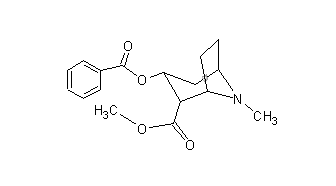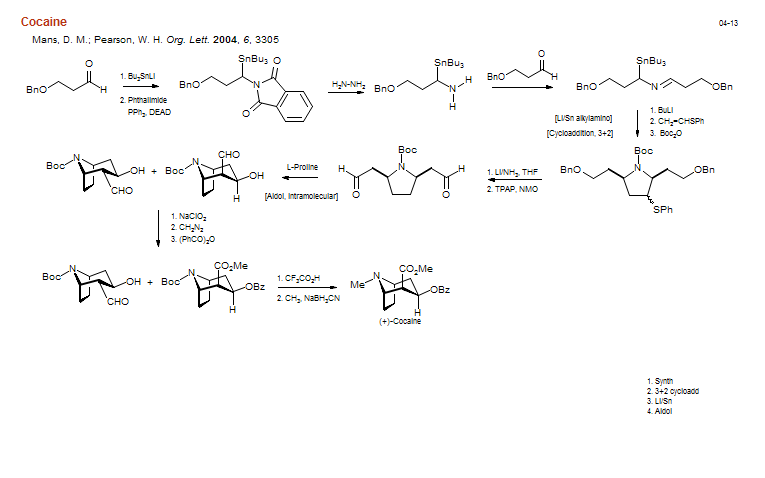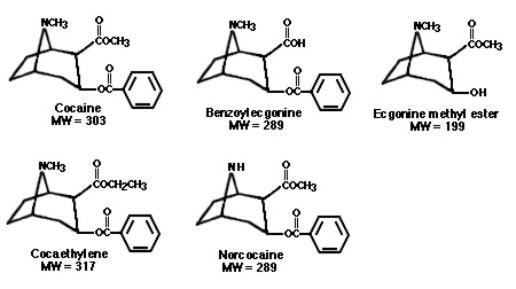It:Cocaine
| Structure of Cocaine | ||||
|---|---|---|---|---|

| ||||
| 3D structure | ||||
| Systematic Name | 2beta-carbomethyoxy-3beta-benzoxytropane | |||
| Alternative Chemical Names | [1R-(exo,exo)]-3-(Benzoyloxy)-8-methyl-8-azabicyclo[3.2.1]octane-2-carboxylic |acid methyl ester, 3beta-hydroxy-1alphaH, 5alphaH-tropane-2beta-carboxylic acid methyl ester |benzoate, l-cocaine, beta-cocaine, benzoylmethyl-ecgonine, ecgonine methyl ester benzoate | |||
| Molecular formula | C17H21NO4 | |||
| Molecular Weight | 303.36 | |||
| Melting Points | 98C(monoclinic tablets)/195C(Hydchloride)/58-63C(nitrate dihydrate) | |||
| Appearance | Crystalline, granular or powder | |||
| Taste | Saline, bitter - numbs mouth area | |||
Cocaine is made from an alkaloid extracted from the Erythroxylon coca plant - a shrub indigenous to the Andean area of South America. It is also possible to synthesise it in a lab from basic starting materials, but it involves more than a dozen steps and yields prove to be miserably low, hence the reliance upon the coca plant for large scale production.
Merck Index Entry
2515. Coca. Erythroxylon; cuca; hayo; ipado. Dried leaves of Erythroxylon coca Lam., Erythroxylaceae. Habit. Bolivia, Brazil, Peru, cultivated in Java. Constit. 0.5-1% alkaloids in the South American, 1.5-2.5% in the Javanese leaves. In the former, the major alkaloid is cocaine; in the latter, there is very little cocaine, the alkaloids, consisting chiefly of ecgonine derivatives such as benzoyl ecgonine, methyl ecgonine, etc. The Java leaves also contain small quantities of tropococaine which is apparently absent in the South American leaves. Other "cocaine" alkaloids present are truxillococaine, isatropylcocaine or cocamine, cocaicine.Merck Index
Synthetic Route
Uses
Cocaine is a stimulant, a vasoconstrictor and can be used as a local anaesthetic. The anaesthetic action works by blocking sensory impulses and the effect is maintained by the constriction of blood vessels. It is also useful during operations as it reduces bleeding (because of vasoconstriction).
Cocaine hydrochloride (4 and 10%) solution is used mainly as a topical local anesthetic for the upper respiratory tract. The vasoconstrictor and local anesthetic properties of cocaine cause anesthesia and mucosal shrinkage. It constricts blood vessels and reduces blood flow, and is used to reduce bleeding of the mucous membranes in the oral, laryngeal, and nasal cavities.DEA
Cocaine has been used for centuries in South America as it allows you to work for extended periods of time without experiencing fatigue or hunger. When used to achieve these effects the drug is taken orally, as there isn’t a large effect when administered this way and so little behavioural alterations.
Recreational users usually inhale the drug in powder form (by ‘snorting’). This is the preferred way to take the drug as the effects are felt within a quarter of an hour and can last up to about an hour depending on the quantity and type of cocaine taken. Cocaine is also injected directly into the blood stream which reduces the time it takes for the effect to set in as the cocaine doesn't need to be absorbed. Cocaine can cause the user to feel in a state of ‘euphoria’. This is achieved by the body blocking the dopamine transporter protein, this means when dopamine is released it cannot be taken up again so there is build up of it in the brain.
Chemistry of Cocaine
The cocaine that is snorted, injected or otherwise introduced directly into the blood stream is an ester of benzoic acid and Ecgonine, an amino alcohol. This is similar in structure to many other local anaesthetics.
Crack Cocaine
Crack cocaine, or simply 'crack' as its known, is the free-base form of cocaine, and is made by preparing an aqueous solution of cocaine hydrochloride and adding ammonia to alkalinize the solution and precipitate the cocaine in its alkaloid form. This form can be smoked, because it vapourises before decomposing, and is popular because of the rapid on effect (3-7 seconds) and more intense sensations. However, these effects last only up to 20 minutes and cause much faster addiction as a result than regular cocaine use.
Pharmacology of Cocaine
Once in the blood stream, cocaine has a 'double whammy' effect on the mind. Firstly, it stimulates the release of dopamine and norepinephrine, and then it inhibits their inhibitors, so the feelings, as described by Freud, of "euphoria, a perceived increase in self control, greater work capacity, perceived long-lasting mental or physical work without fatigue, perceived ability to forego food and sleep" - which he later described as the "perfect illusion" - are all caused by a massive excess of these 'happy' chemicals. This is also what causes the depressive 'come down' experienced by users. The body maintains a carefull balance of dopamine and norepinephrine, so when cocaine disrupts the balance, the body immediately attempts to restore order by releasing more and more inhibitors, which cocaine blocks. This means so long as there is cocaine in the blood stream, the user is on a high, however, as soon as the cocaine has been metabolised, a massive excess of inhibitors is released, causing a lack of dopamine and norepinephrine - leading to a depressive state of mind. This is also how addiction is caused. If cocaine is used very regularly, even for a short period of time, the body and mind adapt to functioning under high dopamine concentrations, so when these return to normal, with no cocaine, the user needs to bring them back up to function properly.
The half-life of cocaine in blood plasma is about 90 minutes. It gets metabolised to benzoylecgonine and ecgonine methyl esterby by plasma esterase and liver enzymes, especially cholinesterase, which is crucial to its breakdown, and a tiny number of deaths have been caused by individuals with hereditary cholinesterase deficiency taking cocaine.
Cocaine and Alcohol
When there is alcohol and cocaine present in the blood stream, as is usually the case, the two form an even more potent stimulant - cocaethylene, an ethyl homologue of cocaine. Having an almost identical pharmacological profile to cocaine, and almost identical effects, the primary reason for its greater stimulation is its increased half-life - 150 minutes.
Cocaine, Cocaethylene and other important Metabolites
Cocaine, Freud and others
The first people to use cocaine where the indiginous people of parts of South America, as thats where the coca plant grows naturally. Large amounts of archeological evidence suggests that the drug was initially only used by the upper social classes and religious figures, as it was thought to have mystical powers. However, from the Incan period onwards (1450s) the drug was used by labourers, soldiers and pretty much everyone for its ability to make people work tirelessly and with little food - hence its comical name 'Columbian marching powder'.
At the end of the nineteenth century, the great psychologist and father of psychoanalysis and dream interpretation, Sigmund Freud, was an avid user of the drug, and around this time he wrote most of his theories on dreams and psychoanalysis. Many others around that time, and much later, until its recent outlawing, would've enjoyed cocaine products. Queen Victoria, Winston Churchill and many others could've enjoyed cocaine bubble gum, proper coca-cola, cocaine tootache drops and many others.
Interesting Cocaine Anekdotes, Myths etc.
Cocaine is very stable, and binds to the ink in banknotes, so almost all the banknotes in circulation, bar the newest ones, will have traces of cocaine on them, so most people handle cocaine every day! Most dogs that are used to search for cocaine are turned into addicts first, so they search for the drugs with an increased vigour and efficiency. The first cocaine cartel was formed, not in Colombia, but in Amsterdam. Founded in 1910, the Cocaine Manufacturers Syndicate included pharmaceutical giants Merck, Sandoz and Hoffman-LaRoche. Up until the 1980's, the CIA actively supported and funded cocaine cartels and dealers who were willing to help in the fight against communism. Coca has been used to measure time and distance, when travellers in ancient South America used to describe journeys in terms the number of coca leaves one chews when making it. Coca-Cola really did contain cocaine
Dangers
Cocaine is cardiotoxic. It can cause: ventricular arrhythmia, angina pectoris and myocardial infarction.
It can also cause seizures, delirium, confusion, paranoia, anorexia (as it suppresses hunger), liver toxicity and probably more. Depending on an individuals sensitivity to the drug.
References
1. http://www.drugfreesport.com/choices/drugs/street/cocaine.html
2. Wikipedia
3. http://designer-drugs.com/pte/12.162.180.114/dcd/chemistry/psychedelicchemistry/chapter8.html


